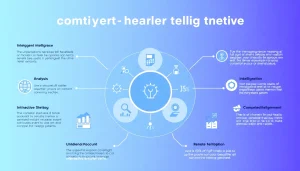Introduction to AI Opinion Polls
As artificial intelligence (AI) continues to permeate various sectors, understanding public sentiment regarding this technology has never been more critical. AI opinion polls are pivotal in gauging how people perceive AI’s benefits and drawbacks. This article delves into the nuances of opinion polling in the context of AI, exploring its definition, significance, and the transformative methodologies AI brings to surveying.
Definition and Importance of Opinion Polls
Opinion polls are systematic methods of gathering public sentiments or beliefs regarding specific issues, events, or technologies. They serve as vital tools for researchers, policymakers, and organizations seeking to understand the perspectives of individuals on a multitude of topics. In the context of AI, polls help uncover public attitudes towards AI technologies, from apprehensions about job displacement to excitement over improved efficiencies.
The importance of these polls is underscored by their ability to inform decisions at both the corporate and governmental levels. Businesses can tailor their products and strategies based on public opinion, while policymakers can craft regulations and initiatives that reflect the sentiments of their constituents.
How AI is Transforming Survey Methodologies
AI is revolutionizing the way surveys are conducted and analyzed. Traditional polling methods often rely on manual data collection and analysis, which can be time-consuming and prone to error. In contrast, AI enhances these methodologies through:
- Automation: AI tools can automate the process of data collection, reducing human error and increasing efficiency.
- Predictive Analytics: By analyzing past data, AI can predict future trends in public sentiment, providing stakeholders with actionable insights.
- Natural Language Processing (NLP): NLP allows for the analysis of open-ended survey responses at scale, leading to richer insights.
- Real-Time Analysis: AI can deliver insights in real-time, making it easier for organizations to adjust their strategies on the fly.
Overview of Current Trends in AI Public Perception
The public’s perception of AI is an ever-evolving landscape. Recent surveys reveal that many Americans are hesitant about the integration of AI into their daily lives, reflecting a complex mix of excitement and apprehension. For instance, a recent poll by Pew Research indicated that as of November 2023, 52% of Americans expressed more concern than excitement about AI, which highlights a significant public skepticism that cannot be overlooked.
These trends suggest that while AI technologies are increasingly being adopted in various sectors—from healthcare to finance—the underlying public sentiment is marked by caution. Being aware of these sentiments enables organizations to engage with their stakeholders effectively.
Recent Findings on AI Sentiment
Analysis of Recent Surveys and Poll Results
Recent surveys reveal a nuanced landscape of public sentiment towards AI. An analysis of data from Gallup and Bentley University indicates that a substantial portion of the U.S. population perceives AI as a potential threat to jobs and privacy. Specifically, a Gallup poll from August 2024 found that a majority of respondents believe AI does more harm than good, particularly in terms of job security and personal data protection.
Furthermore, YouGov research from March 2025 revealed that 40% of Americans consider the impact of AI on society to be negative, showcasing an increasing trend of skepticism. This ongoing monitoring of public sentiment is crucial for organizations aiming to leverage AI technologies responsibly.
Demographics Affected by AI Opinions
When dissecting opinions on AI, demographic factors play a significant role in shaping perspectives. Research indicates that factors such as age, gender, and socioeconomic status influence how individuals view AI:
- Age: Younger individuals tend to show more optimism regarding AI technologies than older generations, who often express concerns rooted in job security and privacy.
- Gender: Data has shown that women, in general, are more skeptical of AI than men. This trend suggests that gender differences may impact the adoption and trust in AI technologies.
- Education: Those with higher education levels tend to have a more informed but cautious approach to AI, often recognizing both its potential benefits and risks.
Comparing Public Views Across Different Sectors
Public sentiment towards AI varies considerably across different sectors. For example, in the healthcare industry, AI is viewed more favorably, with many acknowledging its potential to enhance diagnostics and patient care. Conversely, in the job market, fear of automation and job loss leads to widespread skepticism.
Furthermore, sectors like finance and transportation experience varied opinions based on personal experiences with AI applications—positive interactions can lead to increased acceptance, while negative incidents (such as security breaches) engender distrust.
Understanding these sector-specific dynamics is vital for organizations aiming to implement AI responsibly and effectively.
Challenges in Assessing AI Opinions
Common Misconceptions about AI
The discourse surrounding AI is rife with misconceptions that significantly shape public opinion. One prevalent myth is that AI will entirely replace human jobs. While AI can automate certain tasks, it often complements human skills rather than replacing them outright. Educating the public on this point is essential to alleviating fears and fostering a more nuanced understanding of AI’s role in the workforce.
Another misconception is the belief that AI operates autonomously without human oversight. In reality, AI systems require human intervention for data curation, ethical considerations, and decision-making, which is crucial for maintaining accountability and transparency.
Technical Limitations in AI Polling
While AI significantly enhances polling methodologies, certain technical limitations must be addressed. For example:
- Data Bias: If the data used to train AI models is biased, the insights drawn can perpetuate existing stereotypes and prejudices, skewing public perception further.
- Privacy Concerns: As AI systems often draw on vast amounts of personal data, ensuring user privacy is a critical challenge that affects participation rates in surveys.
- Interpretability: AI-driven models can sometimes function as “black boxes”, making it difficult for researchers to interpret how conclusions are reached, thereby complicating the transparency of polling methodologies.
User Skepticism and Its Impact on Results
User skepticism significantly impacts the accuracy and reliability of AI opinion polls. When individuals lack trust in the technology being used, they are less likely to engage, which can lead to a lower response rate and potentially skewed results. Addressing this skepticism requires organizations to foster transparency regarding how polling data is collected and how results are interpreted. Additionally, ensuring that participants understand the purpose and potential outcomes of the survey can encourage broader engagement.
Best Practices for Conducting AI Opinion Polls
Designing Effective Poll Questions
Creating effective poll questions is fundamental to gathering meaningful insights. Clarity and neutrality are paramount; questions should be straightforward and free from leading language that may bias responses. Utilizing a mix of quantitative and qualitative questions can provide a fuller picture of public sentiment.
For example, instead of asking, “Do you think AI is dangerous?” which may provoke a defensive response, framing the question as “What are your thoughts on the safety of AI technologies?” allows respondents to express a range of opinions.
Leveraging Technology for Enhanced Engagement
To maximize participation in opinion polls, employing innovative technology is essential. Platforms that incorporate gamification, such as interactive surveys or mobile applications, can make participating more engaging. Additionally, employing personalized outreach techniques, based on prior interactions or expressed interests, can foster increased participation.
Strategies for Improving Response Rates
Improving response rates to AI opinion polls entails several strategies:
- Incentives: Offering incentives, such as gift cards or entry into a sweepstakes, can motivate individuals to participate in surveys.
- Targeted Outreach: Utilizing demographic data to target specific groups can lead to more representative results.
- Clear Communication: Outlining the purpose and expected time commitment for the survey can enhance transparency and encourage participatory willingness.
Future of AI Opinion Polls
Predictions for AI’s Role in Public Opinion Research
The future of AI in public opinion research appears promising, with several trends likely to emerge. As AI technologies continue to evolve, their capability to analyze vast datasets will enable polling organizations to deliver more precise insights. Predictive analytics will allow stakeholders to anticipate shifts in public sentiment, facilitating proactive responses.
Moreover, as awareness of AI grows among the public, more individuals may be inclined to engage with opinion polls, leading to richer datasets and insights.
Innovative Approaches for Gathering Insights
Future polling methodologies will likely embrace more innovative approaches, such as:
- Sentiment Analysis: Analysis of social media and online forums will complement traditional surveys, offering insights into public sentiment as conversations evolve.
- Interactive Polling: Real-time polling during events (like webinars or live speeches) can capture immediate reactions, fostering deeper engagement.
- AI-Driven Focus Groups: Leveraging AI to analyze focus group discussions can yield intricate insights regarding nuanced public opinions.
Engaging Stakeholders in AI Discussions
To drive public understanding and discussion around AI, engaging various stakeholders is crucial. Collaborating with educational institutions, businesses, and community organizations can create platforms for dialogue about AI technologies and their implications. This engagement can demystify AI for the public, offering a space for questions, concerns, and constructive feedback.
Furthermore, creating transparent communication channels between developers, policymakers, and the public can ensure that AI is implemented responsibly and ethically.







